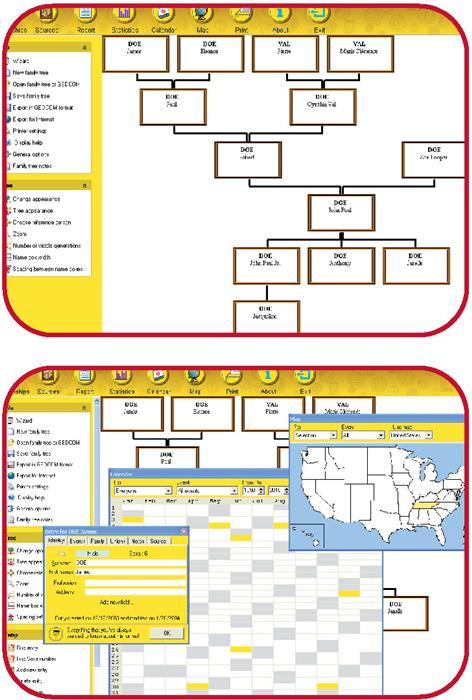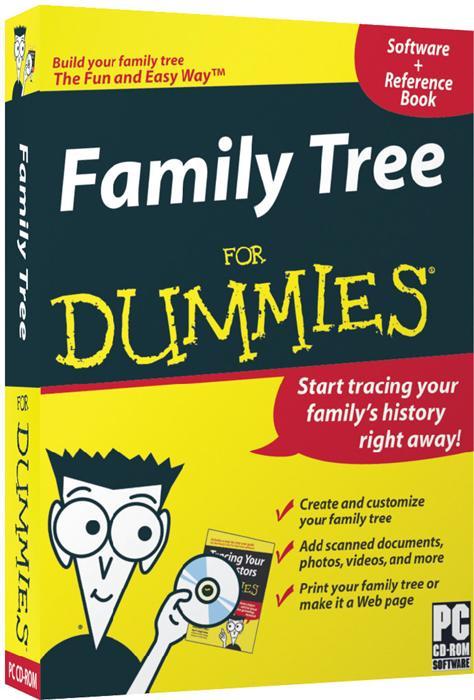Sign up for the Family Tree Newsletter Plus, you’ll receive our 10 Essential Genealogy Research Forms PDF as a special thank you!
Get Your Free Genealogy Forms
"*" indicates required fields
If talk of Ahnentafels and Soundex codes leaves you feeling foolish, the latest entry in the genealogy-software sweepstakes may be an intelligent choice. Family Tree for Dummies <www.dummies-software.com> comes from the folks behind the hugely successful “Dummies” book series. It promises to help you “build your family tree the fun and easy way.”
The software, by Anuman Interactive, comes with a 128-page paperback, Tracing Your Ancestors for Dummies, which also incorporates the user manual. Matthew L. and April Leigh Helm, authors of an earlier guide in the series, Genealogy Online for Dummies, wrote the accompanying book. If all this Dummies branding hasn’t made you feel like a complete idiot by the time you get the box open, you’ll find a not-so-dumb program that’s a good value for beginners at $19.99.
Installation and getting started are a snap; you can play around with the sample family tree included on the CD-ROM until you feel comfortable entering your own ancestors. A toolbar across the top offers buttons for Relationships, Sources, Report, Statistics, Calendar (where colored boxes indicate events you’ve entered — click to go to the event), Map, Print, About and Exit. Below this, the main window shows a standard flow chart-style family tree. Clicking on a box brings up an Entry screen for facts and events about that individual. A list of life events comes built-in, or you can create new ones. Each event entry has spaces for date, place and notes, as well as a Reliable button that lets you rate your confidence in this information (reliable, likely, alleged or unlikely) — a feature we wish more programs would adopt.
You can add parents, siblings, spouses and children for this individual right from the Entry screen, with the Family and Union tabs; as you enter new people, their boxes pop up in the family tree view with the appropriate connections. The Father and Mother spaces on the Family tab also let you rate reliability.
You can create and edit sources from an individual’s Entry screen, or pick an existing source from the list. The program also lets you add images and sounds to source records.
Once you’ve entered some ancestors, you can change the appearance of the tree and the text, and choose how many generations to display at a time. (You can even select one look for males and another for females.) The Report menu lets you search your data, change sort criteria and generate predefined reports ranging from intermarriages to your ancestors’ astrological signs. You can export reports as GEDCOM (the universal family tree file format), HTML, Excel or plain-text files.

The book heavily emphasizes online research, but the specific research recommendations are often bizarre. The chapter on “Ten Handy Databases,” for example, highlights a site called Hyper History Online <www.hyperhistory.com/online_n2/History_ n2/a.html> and two geographic databases, while skimping on real genealogy. The site covered in greatest depth is the defunct GEN-DEX. And this may be the first online-focused genealogy how-to book not to at least mention Cyndi’s List <www.cyndislist.com> (presumably since the Helms created a competing list of links).
Nevertheless, this program is so full-featured that family tree veterans might want to try it, too. It even calculates and lets you find ancestors by Ahnentafel numbers — which, however, it insists on calling “Sosa numbers,” perhaps to make you feel like a dummy.
Family Tree for Dummies requires Windows 98 or higher, 32MB RAM and 20MB hard disk space. Find it at major retailers.
From the February 2005 Family Tree Magazine
ADVERTISEMENT


